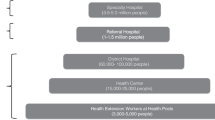Abstract
Low-income women and women of color are disproportionately affected by unintended pregnancy. Lack of knowledge of abortion laws and services is one of several factors likely to hinder access to services, though little research has documented knowledge in this population. Survey with convenience sample of 1,262 women attending primary care or full-scope Ob/Gyn clinics serving low-income populations in three large cities and multivariable analyses with four knowledge outcomes. Among all participants, 53 % were first-generation immigrants, 25 % identified the correct gestational age limit, 41 % identified state parental consent laws, 67 % knew partner consent is not required, and 55 % knew where to obtain abortion services. In multivariable analysis, first-generation immigrants and primarily Spanish speakers were significantly less likely than higher-generation or primarily English speakers to display correct knowledge. Design and evaluation of strategies to improve knowledge about abortion, particularly among migrant women and non-primary English speakers, is needed.
Similar content being viewed by others
References
Finer LB, Zolna MR. Shifts in intended and unintended pregnancies in the United States, 2001-2008. Am J Pub Health. 2014;104:S43–8.
Jones RK, Jerman J. Abortion incidence and service availability in the United States, 2011. Perspect Sex Repro Health. 2014;46(1):3–14.
Jones RK, Darroch JE, Henshaw SK. Patterns in the socioeconomic characteristics of women obtaining abortions in 2000–2001. Perspect Sex Reprod Health. 2002;34(5):226–35.
Jones RK, Kost K, Singh S, Henshaw SK, Finer LB. Trends in abortion in the United States. Clin Obstet Gynecol. 2009;52(2):119–29.
Jones RK, Kavanaugh ML. Changes in abortion rates between 2000 and 2008 and lifetime incidence of abortion. Obstet Gynecol. 2011;117(6):1358–66.
Camarota SA. A record-setting decade of immigration:2000 to 2010. Washington: Center for Inmigration Studies; 2011.
Ostrach B. “Yo no sabia…”—Immigrant women’s use of national health systems for reproductive and abortion care. J Immigr Minor Health. 2013;15:262–72.
Britigan DH, Murnan J, Rojas-Guyler L. A qualitative study examining Latino functional health literacy levels and sources of health information. J Community Health. 2009;34(3):222–30.
Kandula NR, Kersey M, Lurie N. Assuring the health of immigrants: what the leading health indicators tell us. Annu Rev Public Health. 2004;25:357–76.
Martinez-Schallmoser L, Telleen S, MacMullen NJ. The effect of social support and acculturation on postpartum depression in Mexican American women. J Transcult Nurs. 2003;14(4):329–38.
Nielhsen-Bolhman L, Panzer AM, Kindig DA. Health literacy: a prescription to end confusion. Washington, D.C.: National Academy of Sciences; 2004.
Zanchetta MS, Poureslami IM. Health literacy within the reality of immigrants’ culture and language. Can J Public Health. 2006;97(Suppl 2):S26–30.
Selden C, Zorn M, Ratza S, Parker R. Health literacy. Bethesda National Library of Medicine. 2000.
Garbers S, Chiasson MA. Inadequate functional health literacy in Spanish as a barrier to cervical cancer screening among immigrant Latinas in New York City. Prev Chron Dis. 2004;1(4):A07.
Kaiser Family Foundation. Analysis of 2012 current population survey. Bureau of the census. Menlo Park: Kaiser Family Foundation; 2013.
Kaiser Family Foundation. Putting women health care disparities on the map: examining ethnic and racial disparities at the state level. Los Angeles: Kaiser Family Foundation; 2009.
Garces-Palacio IC, Altarac M, Scarinci IC. Contraceptive knowledge and use among low-income Hispanic immigrant women and non-Hispanic women. Contraception. 2008;77(4):270–5.
Mosher WD, Jones J. Use of contraception in the United States: 1982–2008. Vital Health Stat. 2010;23(29):1–44.
Henshaw SK, Joyce TJ, Dennis A, Finer LB, Blanchard K. Restrictions on Medicaid funding for abortions: a literature review. New York: Gutmacher Institute; 2009.
Kacanek D, Dennis A, Miller K, Blanchard K. Medicaid funding for abortion: providers’ experiences with cases involving rape, incest and life endangerment. Perspect Sex Reprod Health. 2010;42(2):79–86.
Trussell J, Menken J, Lindheim BL, Vaughan B. The impact of restricting Medicaid financing for abortion. Fam Plann Perspect. 1980;12(3):120–123, 127–130.
Cockrill K, Weitz TA. Abortion patients’ perceptions of abortion regulation. Womens Health Issues. 2010;20(1):12–9.
Kavanaugh ML, Bessett D, Littman LL, Norris A. Connecting knowledge about abortion and sexual and reproductive health to belief about abortion restrictions: findings from an online survey. Women’s Health Issues. 2013;23(4):e239–47.
Rosing MA, Archbald CD. The knowledge, acceptability, and use of misoprostol for self-induced medical abortion in an urban US population. J Am Med Womens Assoc. 2000;55(3 Suppl):183–5.
Jones RK. How commonly do US abortion patients report attempts to self-induce? Am J Obstet Gynecol. 2011;204(1):23 e21–24.
Grossman D, Holt K, Pena M, Lara D, Veatch M, Cordova D, Gold M, Winikoff B, Blanchard K. Self-induction of abortion among women in the United States. Reprod Health Matters. 2010;18(36):136–46.
Adanu RM, Johnson TR. Migration and women’s health. Int J Gynecol Obstet. 2009;106(2):179–81.
Carballo M, Grocutt M, Hadzihasanovic A. Women and migration: a public health issue. World Health Stat Q. 1996;49(2):158–64.
Llacer A, Zunzunegui MV, del Amo J, Mazarrasa L, Bolumar F. The contribution of a gender perspective to the understanding of migrants’ health. J Epidemiol Community Health. 2007;61(Suppl 2):ii4–10.
Acknowledgments
The authors thank our interviewers: Alma Avila Pilchman, Monti Castaneda, Denisse Cordova, Cecilia Marquez, Erica Seppala, and Margarita Velasco, as well as the clinic staff who helped coordinate the study at each site. The authors also thank the Society of Family Planning, Wallace A. Gerbode Foundation, David and Lucille Packard Foundation, Mary Wohlford Foundation, and an anonymous donor. The views and opinions expressed are those of the authors and do not necessarily represent the views and opinions of the Society of Family Planning.
Author information
Authors and Affiliations
Corresponding author
Rights and permissions
About this article
Cite this article
Lara, D., Holt, K., Peña, M. et al. Knowledge of Abortion Laws and Services Among Low-Income Women in Three United States Cities. J Immigrant Minority Health 17, 1811–1818 (2015). https://doi.org/10.1007/s10903-014-0147-z
Published:
Issue Date:
DOI: https://doi.org/10.1007/s10903-014-0147-z




